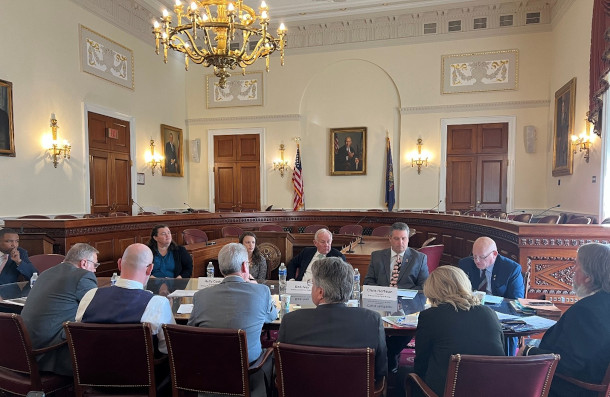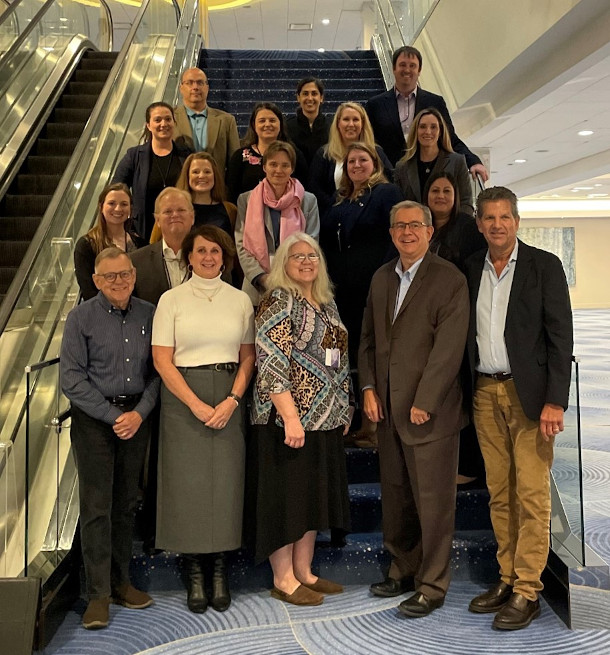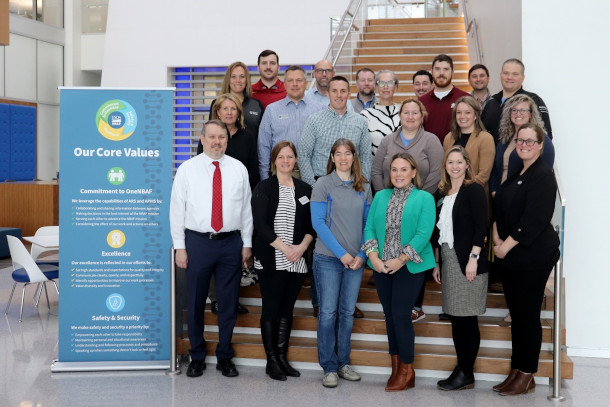Capital Update – For the Week Ending March 29, 2024
In this week’s National Pork Producers Council (NPPC) Friday recap: NPPC leads bipartisan discussion on implications of Prop. 12, Question 3; USDA’s latest Hogs and Pigs Report portends positive 2024; coalition weighs in on proposed effluent guidelines for meat packers; NPPC participates in HHS Healthy People 2030 initiative; swine veterinarians tour National Bio and Agro-Defense Facility. Take a deeper dive below.
NPPC leads bipartisan discussion on implications of Prop. 12, Question 3 | USDA’s latest Hogs and Pigs Report portends positive 2024 | coalition weighs in on proposed effluent guidelines for meat packers | NPPC participates in HHS Healthy People 2030 initiative | swine veterinarians tour National Bio and Agro-Defense Facility
NPPC Leads Bipartisan Discussion on Implications of Prop. 12, Question 3
What happened: House Agriculture Committee Chairman Glenn “GT” Thompson (R-PA) hosted a bipartisan roundtable discussion on the implications of California Proposition 12 and Massachusetts Question 3, which prohibit the sale of pork in those states from sows raised in housing that does not meet their arbitrary standards.
NPPC board member Bob Ivey, a producer from Goldsboro, NC, and economist Holly Cook presented to members of Congress on the economic and on-farm impacts of these measures.
Chairman Thompson has repeatedly said he will include language in the committee’s Farm Bill that would fix Prop. 12 and Question 3, pre-empting the measures by prohibiting states and localities from regulating the means and methods of agricultural production outside their borders.
NPPC’s take: NPPC supports Chairman Thompson’s efforts to address the issues caused by the two ballot initiatives.
The U.S. Department of Agriculture’s Office of the Chief Economist’s office recently analyzed data and found that Prop. 12 already has raised pork prices for California consumers and decreased pork sales volumes in the state. Pork loins, ribs, and bellies have seen an average 20% price increase since before July 1, 2023 — when the initiative was partially implemented — with loin prices averaging 41% higher than before Prop. 12 implementation.
Why it matters: For most pork producers, complying with these measures means costly renovations or new construction, adding to the financial strain after significant losses in 2023. Additionally, allowing these laws to stand could pave the way for similar regulations in other states, leading to a fragmented regulatory landscape nationwide.

Holly Cook (left of center) and Bob Ivey (center) present to House Agriculture Committee members on implications of Prop 12 and Question 3.
USDA’s Latest Hogs and Pigs Report Portends Positive 2024
What happened: The U.S. Department of Agriculture issued its quarterly Hogs and Pigs Report for the three months covering Dec. 1, 2023, to March 1, 2024, showing a slightly larger swine herd year-over-year and a small reduction in the sow herd.
Quarterly farrowings were down by 2.6% from the same quarter in 2023, while farrowing intentions for March through May and June through August were down 1.3 and 1.7%, respectively, though higher than analysts expected. Pigs saved per litter reached a record 11.53 for the quarter, up from 11.02 in the same quarter in 2023. As a result, and despite fewer sows and farrowings, the market hog inventory was up by 0.8% to 68.556 million as of March 1, 2024, compared with 67.990 million as of March 1, 2023.
Economist Steve Meyer, with Ever.Ag Financial Services, said the improvement in pigs saved pigs per litter, moderating feed costs, strong domestic and international demand for U.S. pork, and rising beef prices point to a more positive outlook for producers in 2024 than 2023. He raised concerns about the third and fourth quarters when hog supply could outstrip capacity at packing plants, particularly given the closure of the Tyson Foods facility in Perry, Iowa.
On the export front, Brett Stuart, president and co-founder of Global AgriTrends, expects U.S. pork exports to be 6% higher than 2023’s record on strong international demand and ongoing swine herd liquidations from some of the United States’ largest competitors, including China and the European Union.
Why it matters: The quarterly Hogs and Pigs Report can help inform future expectations for hog and pork supplies, helping producers better understand the economic conditions of the U.S. pork industry.
Coalition Weighs in on Proposed Effluent Guidelines for Meat Packers
What happened: NPPC, along with other members of the Meat and Poultry Products (MPP) Industry coalition, submitted extensive comments on the U.S. Environmental Protection Agency’s (EPA’s) proposed effluent permitting guidelines for meatpacking plants under the Clean Water Act. If adopted, the new rule would apply to many of the nation’s 5,000 meat and poultry plants, requiring them to upgrade facilities and install costly wastewater treatment technologies.
The coalition asked EPA to provide additional information, including studies, to confirm the various bases for its effluent proposal, correct errors in the rule, and narrow the regulation to cover only facilities that directly discharge to waterways (the proposed rule also covers “indirect” dischargers) — or withdraw and issue a new rule by updating 2004 effluent guidelines that include technology-based standards applicable to direct discharging facilities.
NPPC’s Take: The coalition objected to EPA’s rulemaking process, which did not provide the meat and poultry industry with sufficient time to evaluate critical information and provide meaningful public comments on the proposed rule. The agency also did not disclose for review hundreds of pages of detailed analyses and more than 600 other supporting documents until after the proposed rule was published in the Federal Register.
The MPP coalition said EPA’s economic impact and environmental analyses on the proposed rule “suffered from a number of deficiencies,” including underestimating the compliance costs and job losses. EPA estimated that its preferred approach would “only” result in 16 processing plants being closed. However, based on extensive new records EPA released one day before comments were due, the coalition estimates the proposal would cost nearly $1.2 billion per year, result in at least 74 meat processing plants closing, and lead to the direct loss of 31,500-78,500 jobs and up to 316,000 total jobs lost across the economy. These impacts will fall disproportionally on small and medium packers and processors.
Why it matters: While the agricultural industry and the meat and poultry processing sector support efforts to protect waterways, regulations must not place costly, undue burdens on the regulated community. Pork producers need a stable and reliable marketplace for their animals. EPA’s proposal will significantly disrupt packing capacity and inflict additional severe financial harm on producers, potentially leading to further industry concentration and the loss of independent producers.
NPPC Participates in AFDO Healthy People 2030 Workgroup
What happened: NPPC director of food policy Dr. Ashley Johnson participated in the Association of Food and Drug Officials (AFDO) Healthy People 2030 Workgroup, tasked with identifying and implementing measurable solutions to meet or exceed the U.S. Department of Health and Human Services’ (HHS’s) Healthy People 2030 food safety objectives. The Healthy People 2030 initiative is a 10-year plan for tackling key public health priorities and challenges.
Offering individuals, organizations, and communities ways to improve health and well-being, the initiative includes more than 350 science–based and measurable objectives with “ambitious but achievable” targets. The objectives and framework — including foundational principles, overarching goals, and a plan of action — were developed with expert input across more than 20 federal agencies and through public comments from stakeholders representing multiple sectors.
NPPC’s take: NPPC supports this initiative and serves as an industry voice to help guide national health-promotion and disease-prevention efforts. Collaborative efforts will enhance the knowledge of current food safety practices in the pork industry and help achieve the Health People 2030 food safety goals.
Why it matters: Healthy People 2030, the fifth iteration of the initiative, builds on knowledge gained over the past four decades to address the latest public health priorities and challenges.

Dr. Johnson (second from right on second row) and other public health experts discuss the 10-year plan for public health at Healthy People 2030.
Swine Veterinarians Tour National Bio and Agro-Defense Facility
What happened: NPPC hosted nine swine veterinarians for a tour of the U.S. Department of Agriculture’s National Bio and Agro-Defense Facility (NBAF). Located in Manhattan, Kansas, this new state-of-the-art laboratory is vital for safeguarding the nation’s agriculture from serious animal diseases.
Accompanied by NPPC director of animal health Dr. Anna Forseth, the veterinarians learned about NBAF’s expanding research and diagnostic capabilities, including the new Biologics Development Module that will support pilot-scale development of vaccines and other disease countermeasures, as well as the facility’s structure and security.
The Biosafety Level-4 facility — the first in the United States — will be equipped to study high-consequence zoonotic diseases affecting livestock.
Why it matters: NBAF will replace the 68-year-old Plum Island Animal Disease Center (PIADC), a Biosafety Level-3 facility located off the eastern tip of Long Island, New York, where USDA’s Agricultural Research Service and Animal and Plant Health Inspection Service currently conduct foreign animal disease research, training, and diagnostics.
Among the diseases of focus at PIADC and, eventually, NBAF are ones of most concern to the U.S. pork industry: African swine fever (ASF), classical swine fever (CSF), and foot-and-mouth disease (FMD).

Swine veterinarians from across the country tour NBAF.